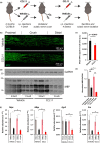Inflammaging impairs peripheral nerve maintenance and regeneration
- PMID: 30168637
- PMCID: PMC6260910
- DOI: 10.1111/acel.12833
Inflammaging impairs peripheral nerve maintenance and regeneration
Abstract
The regenerative capacity of peripheral nerves declines during aging, contributing to the development of neuropathies, limiting organism function. Changes in Schwann cells prompt failures in instructing maintenance and regeneration of aging nerves; molecular mechanisms of which have yet to be delineated. Here, we identified an altered inflammatory environment leading to a defective Schwann cell response, as an underlying mechanism of impaired nerve regeneration during aging. Chronic inflammation was detected in intact uninjured old nerves, characterized by increased macrophage infiltration and raised levels of monocyte chemoattractant protein 1 (MCP1) and CC chemokine ligand 11 (CCL11). Schwann cells in the old nerves appeared partially dedifferentiated, accompanied by an activated repair program independent of injury. Upon sciatic nerve injury, an initial delayed immune response was followed by a persistent hyperinflammatory state accompanied by a diminished repair process. As a contributing factor to nerve aging, we showed that CCL11 interfered with Schwann cell differentiation in vitro and in vivo. Our results indicate that increased infiltration of macrophages and inflammatory signals diminish regenerative capacity of aging nerves by altering Schwann cell behavior. The study identifies CCL11 as a promising target for anti-inflammatory therapies aiming to improve nerve regeneration in old age.
Keywords: aging; inflammaging; macrophages; neural regeneration; peripheral nervous system; schwann cell.
© 2018 The Authors. Aging Cell published by the Anatomical Society and John Wiley & Sons Ltd.
Figures







Similar articles
-
Resveratrol regulates the recovery of rat sciatic nerve crush injury by promoting the autophagy of Schwann cells.Life Sci. 2020 Sep 1;256:117959. doi: 10.1016/j.lfs.2020.117959. Epub 2020 Jun 10. Life Sci. 2020. PMID: 32531375
-
α6 and β1 Integrin Heterodimer Mediates Schwann Cell Interactions with Axons and Facilitates Axonal Regeneration after Peripheral Nerve Injury.Neuroscience. 2018 Feb 10;371:49-59. doi: 10.1016/j.neuroscience.2017.11.046. Epub 2017 Dec 6. Neuroscience. 2018. PMID: 29223350
-
After Nerve Injury, Lineage Tracing Shows That Myelin and Remak Schwann Cells Elongate Extensively and Branch to Form Repair Schwann Cells, Which Shorten Radically on Remyelination.J Neurosci. 2017 Sep 13;37(37):9086-9099. doi: 10.1523/JNEUROSCI.1453-17.2017. Epub 2017 Aug 3. J Neurosci. 2017. PMID: 28904214 Free PMC article.
-
Effects of Pacap on Schwann Cells: Focus on Nerve Injury.Int J Mol Sci. 2020 Nov 3;21(21):8233. doi: 10.3390/ijms21218233. Int J Mol Sci. 2020. PMID: 33153152 Free PMC article. Review.
-
Neuregulin 1 role in Schwann cell regulation and potential applications to promote peripheral nerve regeneration.Int Rev Neurobiol. 2013;108:223-56. doi: 10.1016/B978-0-12-410499-0.00009-5. Int Rev Neurobiol. 2013. PMID: 24083437 Review.
Cited by
-
Role of Transforming Growth Factor Beta in Peripheral Nerve Regeneration: Cellular and Molecular Mechanisms.Front Neurosci. 2022 Jun 13;16:917587. doi: 10.3389/fnins.2022.917587. eCollection 2022. Front Neurosci. 2022. PMID: 35769702 Free PMC article. Review.
-
Autologous Platelet-Rich Growth Factor Reduces M1 Macrophages and Modulates Inflammatory Microenvironments to Promote Sciatic Nerve Regeneration.Biomedicines. 2022 Aug 17;10(8):1991. doi: 10.3390/biomedicines10081991. Biomedicines. 2022. PMID: 36009539 Free PMC article.
-
Endoneurial immune interplay in peripheral nerve repair: insights and implications for future therapeutic interventions.Front Neurosci. 2025 May 9;19:1602112. doi: 10.3389/fnins.2025.1602112. eCollection 2025. Front Neurosci. 2025. PMID: 40415889 Free PMC article. Review.
-
Transcriptome Analysis of Left Versus Right Intrinsic Laryngeal Muscles Associated with Innervation.Laryngoscope. 2024 Aug;134(8):3741-3753. doi: 10.1002/lary.31487. Epub 2024 May 9. Laryngoscope. 2024. PMID: 38721727 Free PMC article.
-
Proteomic analysis of peripheral nerve myelin during murine aging.Front Cell Neurosci. 2023 Oct 30;17:1214003. doi: 10.3389/fncel.2023.1214003. eCollection 2023. Front Cell Neurosci. 2023. PMID: 37964793 Free PMC article.
References
-
- Boivin, A. , Pineau, I. , Barrette, B. , Filali, M. , Vallieres, N. , Rivest, S. , & Lacroix, S. (2007). Toll‐like receptor signaling is critical for Wallerian degeneration and functional recovery after peripheral nerve injury. The Journal of Neuroscience : the Official Journal of the Society for Neuroscience, 27, 12565–12576. 10.1523/JNEUROSCI.3027-07.2007 - DOI - PMC - PubMed
MeSH terms
Substances
Grants and funding
LinkOut - more resources
Full Text Sources
Other Literature Sources
Medical
Molecular Biology Databases
Research Materials

